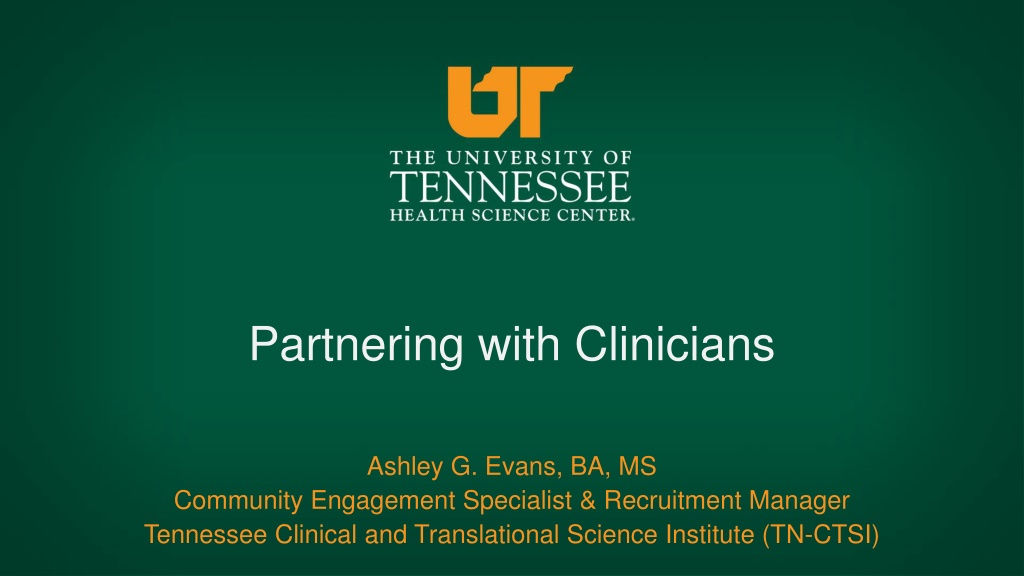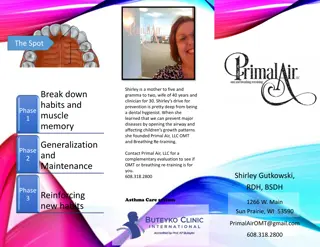Strategies for Effective Clinician Partnership in Translational Science
Engage clinicians effectively by building relationships, addressing barriers, and highlighting benefits. Understand clinician perspectives and leverage established patient relationships to advance translational science research. Overcome participation barriers for both clinicians and patient-participants to drive successful collaborations.
Uploaded on Sep 08, 2024 | 0 Views
Download Presentation

Please find below an Image/Link to download the presentation.
The content on the website is provided AS IS for your information and personal use only. It may not be sold, licensed, or shared on other websites without obtaining consent from the author. Download presentation by click this link. If you encounter any issues during the download, it is possible that the publisher has removed the file from their server.
E N D
Presentation Transcript
Partnering with Clinicians Ashley G. Evans, BA, MS Community Engagement Specialist & Recruitment Manager Tennessee Clinical and Translational Science Institute (TN-CTSI)
Overview Planning Conducting Resources
Building Relationships and Trust Conduct initial site visit Obtain buy-in from office managers, nurses, medical assistants and all involved Distribute site survey Address structural barriers that impact clinician s patients Stress trial safety Clear expectations & understanding Explain study benefits Be candid about risks
Building Relationships and Trust Highlight clinical relevance and timeliness of research What are the deliverables? How does the study match up with the clinician s goals? Be prepared to answer research and non-research clinical questions Create win-win situation
Benefits to Partnering with Clinicians Relationships with potential participants is already established Offers patients access to innovative and cutting- edge research treatment Progresses the field of field of translational science & research
Barriers to Participation Clinicians Time commitment Lack of clinical equipoise Concern for patients Taking them away Lack of recognition/reward Difficulty with consent process Lack of infrastructure for research
Barriers to Participation Patient-Participants Additional appointments Transportation Mistrust Time commitment Dissatisfaction with study assignment Will it work for them?
Single Sites vs. Networks Single Sites Pros: Logistically easier to manage involvement Simplified data collection Population is less heterogeneous Possibly cheaper Cons: Relatively smaller amount of patient-participants Slower accumulation of patient-participants Limited external validity
Single Sites vs. Networks Networks Pros: Access to larger amount of patient-participants Potential findings more generalizable Cons: Navigating various groups and relationships Will all physicians say yes?
Explain Study Benefits Patients Playing a more active role in their own health care Gaining access to new treatments not available to the public Possibly receiving a treatment that works for their condition Getting expert medical care Helping others by contributing to medical research Access to information about support groups and other resources
Explain Study Benefits Clinicians Is this practical research for their patients' lives? What do their patients gain from participation? How does your study align with their practice? What value does your study add to their practice?
Minimize Clinician Workload Provide contact information that patient- participants can access (Ex: phone number, email, website) Create one step process for referrals Manage the consent process Provide one to two study points for clinicians to use to introduce research to potential participants
Minimize Clinician Workload Continue conducting site visits Designate a clinic liaison Create a concierge service to assist in scheduling research and non-research related appointments and connections
Acknowledge & Celebrate Clinicians Contributions Provide clinicians with regular updates about the study Utilize electronic workflows to make this easier! Make clinicians proud to be a part of the research team Show appreciation to the clinic staff Small gifts & food Send thank you notes Acknowledgement in research publications
Remember! Under NIH and Common Rule IRB guidelines, both multi-site and cooperative research projects may: Require the use of a single IRB for oversight. Have a lead site/PI who receives the grant or contract from a sponsor and then establishes a subaward or subcontract to each participating site. Require Reliance Agreements to establish the contractual terms for IRB oversight and project management Note: The UTHSC IRB does not have the staff or resources at this time to serve as the Single/Reviewing IRB for a multisite (e.g., national) study.
Resources Trial Innovation Network SMART IRB If you are interested in conducting a multi-site study, contact the UTHSC IRB Kimberly Williams, IRB Reliance Manager kwilli72@uthsc.edu
ASSISTANCE REQUEST FORM tnctsi.uthsc.edu Consultation and Services Assistance Request Form
Become a Member! Complete a membership application: https://tnctsi.uthsc.edu/about/become-a- member/ Also submit a biosketch, curriculum vitae, or resume It s free! TN-CTSI Member benefits include: Added to the Listserv Training and Career Development Research Opportunities and Connections Access to our member directory allowing discovery of fellow researchers and collaborators
Resources and more can be found Resources and more can be found in the following locations: in the following locations: TN-CTSI website https://tnctsi.uthsc.edu/ TN-CTSI office 66 N. Pauline Suite 232 901-448-2874 tnctsi@uthsc.edu Need Additional Help? Contact: Need Additional Help? Contact: Ashley Evans, BA, MS, Community Engagement Specialist & Recruitment Manager aevans48@uthsc.edu Derita Bran, MSN, RN, CCRC, Program Director, Director of Administration dbran@uthsc.edu

























